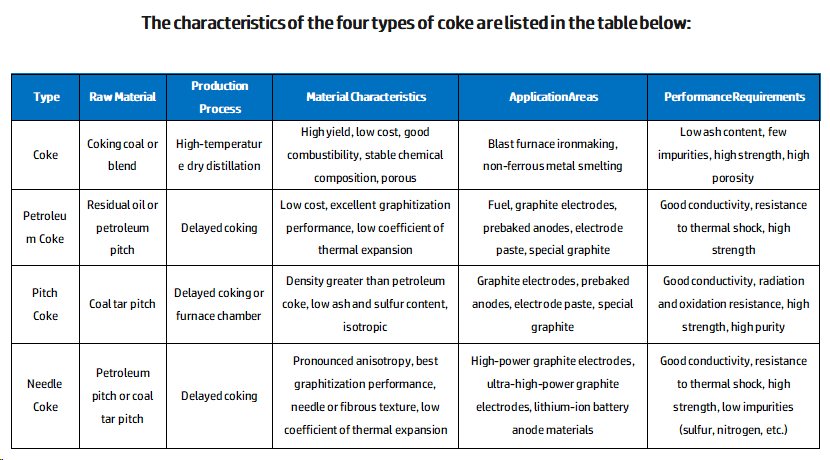【Carbon Science】Differences and Uses of Coke, Pitch Coke, Needle Coke, and Petroleum Coke

【Carbon Science】Introduction to the Differences and Uses of Coke, Pitch Coke, Needle Coke, and Petroleum Coke
Coke is a solid product formed by heating raw materials such as coking coal or a mixture of coals to 1000°C under oxygen-free conditions through high-temperature distillation, generating gases, and coal tar. Pitch coke is a solid material formed by high-temperature carbonization of coal tar pitch. Needle coke, produced by liquid-phase carbonization of coal tar pitch or petroleum pitch and subsequent high-temperature carbonization processes, exhibits a needle-like texture, and related products-Physical and chemical properties of graphitized petroleum coke. Petroleum coke is formed by high-temperature carbonization of residual oil or petroleum pitch.

Coke mainly consists of carbon and contains small amounts of hydrogen, oxygen, nitrogen, sulfur, and trace metal elements. It is indispensable in blast furnace ironmaking, as it provides heat and acts as a reducing agent for iron ore. China has a massive demand for coke in blast furnace ironmaking, with a coke production of 4.49 billion tons in 2016.
Petroleum coke, derived from the process of distilling crude oil to separate light and heavy oils, involves the further thermal cracking of heavy oils. Visually, petroleum coke appears as irregularly shaped, variably sized black chunks (or particles) with a metallic luster. The particles of petroleum coke exhibit a porous structure, with carbon being the predominant element, constituting over 80% of its composition. It contains hydrogen in the range of 1.5% to 8%, with the remainder consisting of oxygen, nitrogen, sulfur, and metallic elements.
Petroleum coke, a type of easily graphitizable carbon, exhibits a more orderly arrangement of crystalline grids compared to metallurgical coke. Under high-temperature graphitization, the average thickness (Lc) and width (La) of the crystalline grid sheets increase, and the distance between the sheets (d) decreases. The lattice constants (a0 and c0) approach natural graphite, resulting in significantly reduced electrical resistivity and increased true density. Therefore, using petroleum coke as a raw material can produce graphite electrodes with lower electrical resistivity.
Petroleum coke has unique physical, chemical, and mechanical properties. The non-volatile carbon in the heating portion, volatile matter, and impurities such as sulfur, metal compounds, water, and ash determine the chemical properties of coke. The porosity and density in physical properties determine the reactivity and thermophysical properties of coke. Particle composition, processing methods, hardness, wear resistance, strength, and other mechanical characteristics determine its mechanical properties.
Coal tar pitch has higher aromaticity than petroleum pitch. Pitch Coke produced from coal tar pitch has lower sulfur content, volatile matter, and ash than petroleum coke, with a denser structure and lower porosity.
Needle coke has higher requirements for raw materials, as impurities and heteroatoms in pitch affect the formation of a wide-range mesophase, a necessary condition for high-quality needle coke. Therefore, whether using coal tar pitch or petroleum pitch as a raw material for needle coke production, pre-treatment is required to reduce mechanical impurities and primary quinoline-insoluble (QI), while minimizing the content of sulfur, nitrogen, oxygen, and other heteroatoms to produce excellent needle coke. For more information on the coke market, feel free to contact us at any time.
No related results found








0 Replies